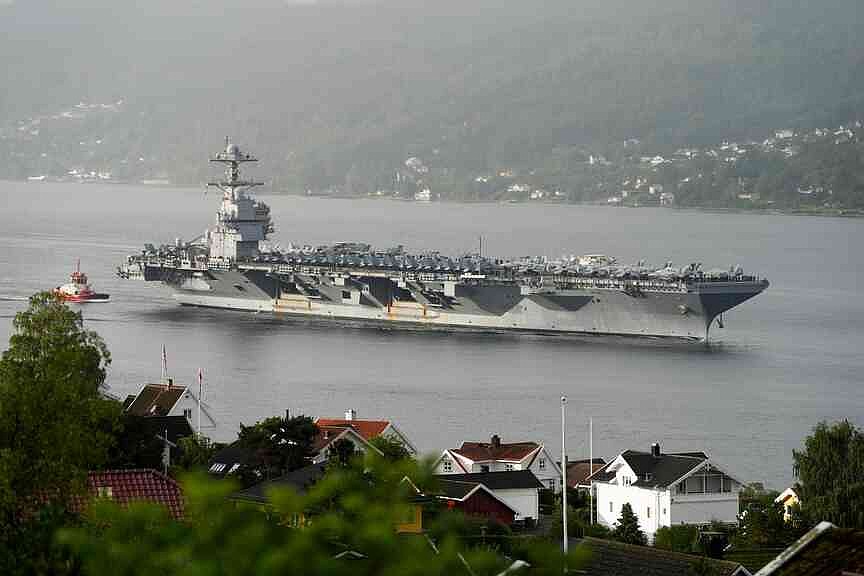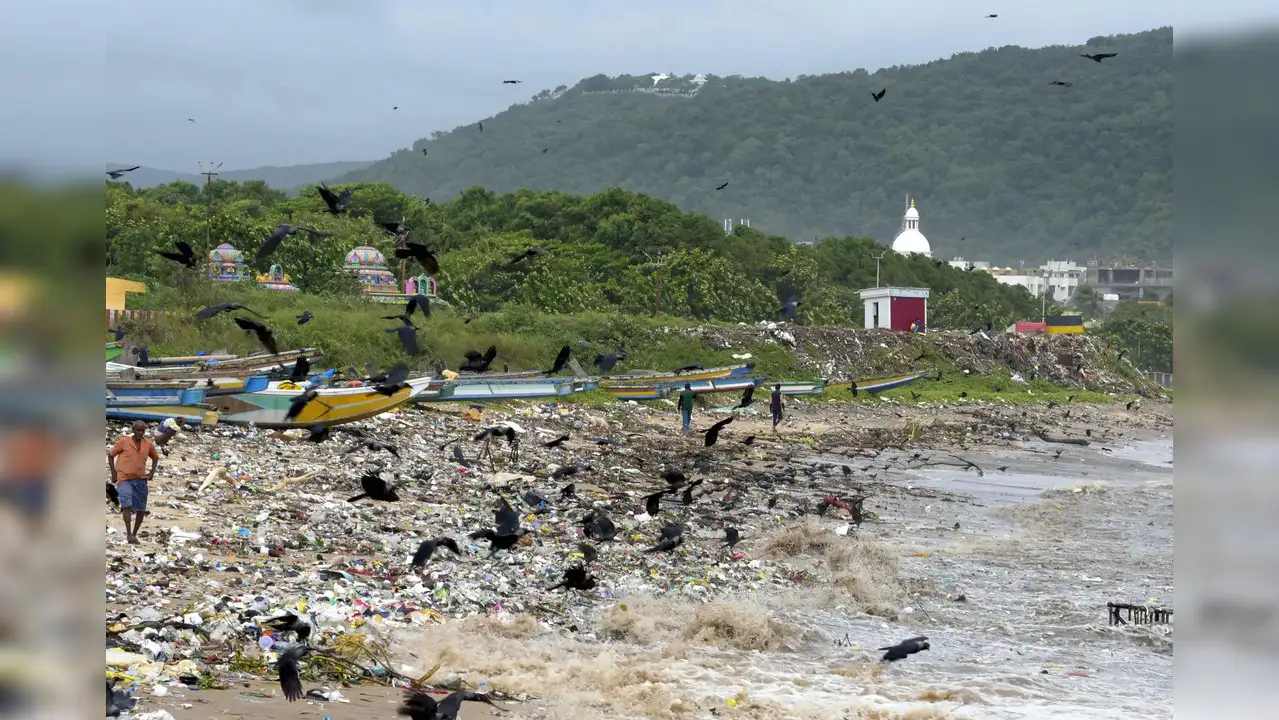Copyright Arkansas Online

WASHINGTON -- President Donald Trump's decision to shift the nation's most advanced aircraft carrier to South America in his campaign against drug cartels is pulling the ship out of the Mediterranean Sea at a time when a tenuous ceasefire between Israel and Hamas has been threatened by new strikes in Gaza. In another military development, the U.S. confirmed Wednesday that it will reduce its troop presence on NATO's borders with Ukraine but shed no light on any future cuts, as its allies worry about a security gap being created at a time when Russia is increasingly confrontational. The U.S. is set to be in the fairly unusual position of having only a single aircraft carrier deployed and none in the waters off both Europe and the Middle East. The change is especially stark after the U.S. joined Israeli strikes on Iran in June and has engaged in some of the most intense combat operations since World War II against Yemen's Houthi rebels in the Red Sea. Aircraft carriers, with their thousands of sailors and dozens of warplanes, have long been recognized as one of the ultimate signifiers of U.S. military might and the nation's foreign policy priorities. There have been five carrier deployments to the Middle East since the Hamas-led attack on Israel on Oct. 7, 2023, including two carriers in the region at multiple points this year and last. The new orders for the USS Gerald R. Ford illustrate the Trump administration's increasing focus on the Western Hemisphere and mark a major escalation of firepower as the U.S. military ramps up fatal strikes on suspected drug boats. With a buildup of warships, aircraft and troops already in the region, Trump himself has signaled what could be next. Speaking from another aircraft carrier, the USS George Washington, in its home port of Japan, Trump noted the U.S. attacks at sea and reiterated that "now we'll stop the drugs coming in by land." Mark Cancian, a senior adviser with the Center for Strategic and International Studies and a retired Marine colonel, questioned how long the Ford would be able to remain in South America, when only three of the 11 U.S. aircraft carriers are typically out to sea. "It's such a powerful and scarce resource, there will be a lot of pressure to do something or send it elsewhere," Cancian said. "You can imagine the peace negotiations breaking down in the eastern Mediterranean or something happening with Iran." RUMBLES IN VENEZUELA Meanwhile, the U.S. military's growing presence near Venezuela and its 14 fatal strikes on suspected drug boats have stoked fears that Trump could try to topple authoritarian President Nicolás Maduro, who faces charges of narcoterrorism in the U.S. In response to questions about the speculation, Secretary of State Marco Rubio insisted Saturday that the U.S. is taking part in a counterdrug operation. And he again accused Maduro's government of participating in the shipment of narcotics. Experts say the U.S. forces in the region aren't large enough for an invasion. But they could help push out Maduro -- and possibly plunge the nation into chaos. "There's a really high potential for violence and instability," according to Geoff Ramsey, an expert on U.S. policy toward Venezuela who is a senior fellow at the Atlantic Council. If Maduro loses power, he said Venezuela could "devolve into a Libya-style meltdown that could last years." The Ford strike group, which includes five destroyers, will add to an unusually large U.S. military buildup in the waters off Venezuela. The Navy already has eight warships in the region -- three destroyers, three amphibious assault ships, a cruiser and a smaller littoral combat ship that's designed for coastal waters. It was not clear if all five of the destroyers in the Ford strike group would make the journey. The administration says the military has killed at least 61 people in the strikes against vessels accused of transporting drugs. Trump has declared drug cartels to be unlawful combatants because of narcotics flowing into the country and said the U.S. is in an "armed conflict" with them, relying on the same legal authority used by the Bush administration after 9/11. Defense Secretary Pete Hegseth announced the destruction of a 14th boat late Wednesday with four deaths. A SHIFT IN EUROPE News of the U.S.' decision to reduce its presence near Ukraine first came from Romania, whose defense minister said the decision reflects Washington's shift "toward the Indo-Pacific" region. However, Ionut Mosteanu said allied troop numbers would remain above the number before Russia's full-scale invasion of neighboring Ukraine in 2022. The U.S. armed forces later confirmed the move, but denied it was a sign of lessened commitment to NATO. Analysts say it might tempt Russia to test the military alliance. Depending on operations and exercises, around 80,000-100,000 U.S. troops are usually present on European soil. NATO allies have expressed concern that the Trump administration might drastically cut their numbers and leave a security vacuum as European countries confront an increasingly aggressive Russia. The administration has been reviewing its military "posture" in Europe and elsewhere, but U.S. officials have said that the findings of the review were not expected to be known before early next year. NATO has recently been bulking up its defensive posture on its eastern flank bordering Belarus, Russia and Ukraine after a series of airspace violations by drones, balloons and Russian aircraft. The Romanian defense ministry said the U.S. decision will "stop the rotation in Europe of a brigade that had elements in several NATO countries," including at a base in Romania. It said in a statement that about 1,000 U.S. troops will remain stationed in Romania. As of April, more than 1,700 U.S. military personnel were estimated to be deployed there. A brigade usually numbers anywhere from 1,500 to 3,000 troops. "Our strategic partnership is solid, predictable and reliable," Mosteanu said in a news conference. In a post on X, U.S. Ambassador to NATO Matthew Whitaker said the U.S. "remains committed to Romania." U.S. TROOPS RETURNING In a statement later on Wednesday, U.S. Army Europe and Africa said the 2nd Infantry Brigade Combat Team of the 101st Airborne Division will return to its base in Kentucky as previously planned but that no other U.S. troops would rotate into Europe to replace it. "This is not an American withdrawal from Europe or a signal of lessened commitment to NATO and Article 5," it said, in a reference to the collective security guarantee in the organization's treaty that an attack on one ally should be considered an attack on all 32. "Rather this is a positive sign of increased European capability and responsibility. Our NATO allies are meeting President Trump's call to take primary responsibility for the conventional defense of Europe," it said. It insisted the move "will not change the security environment in Europe." However, top Republican lawmakers overseeing the military in Congress spoke out against the move. In a joint statement, Sen. Roger Wicker and Rep. Mike Rogers, who chair committees overseeing the U.S. military, said it "sends the wrong signal to Russia at the very moment President Trump is applying pressure to force Vladimir Putin to come to the table to achieve a lasting peace in Ukraine." Officials in Poland and Lithuania, which lie farther north on Europe's eastern flank, said they had not been told of any U.S. drawdown in their countries. Giuseppe Spatafora, research analyst at the EU Institute for Security Studies, said that while the full extent of the American withdrawal is not yet known, "we do know the direction of travel: fewer US troops and assets, and an expectation that Europeans will fill the gap." Information for this article was contributed by Claudia Ciobanu and Geir Moulson of The Associated Press.



